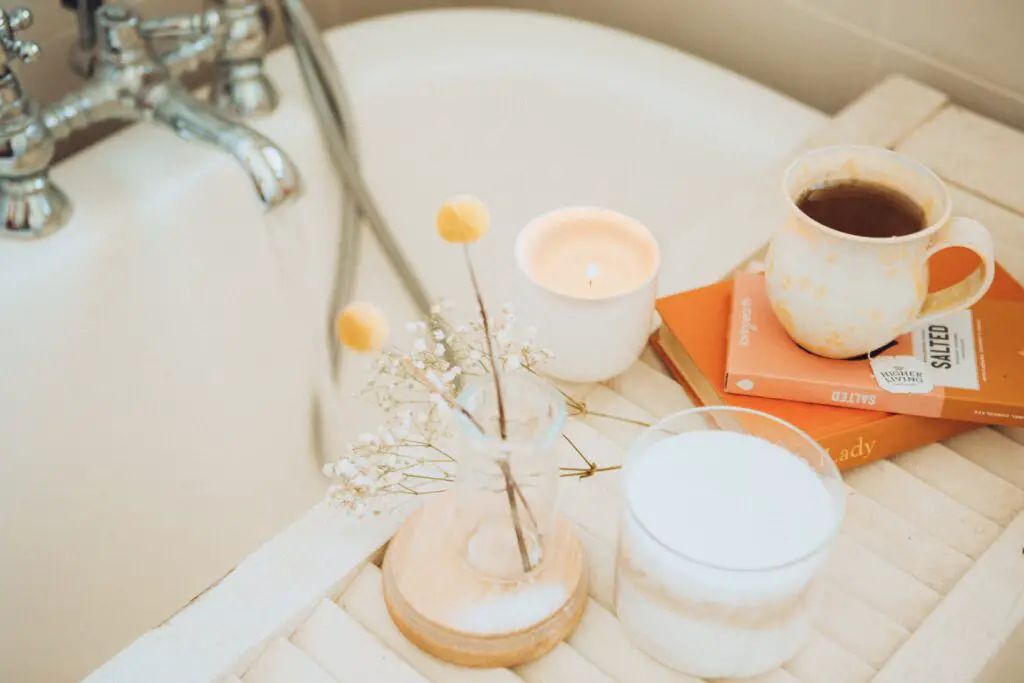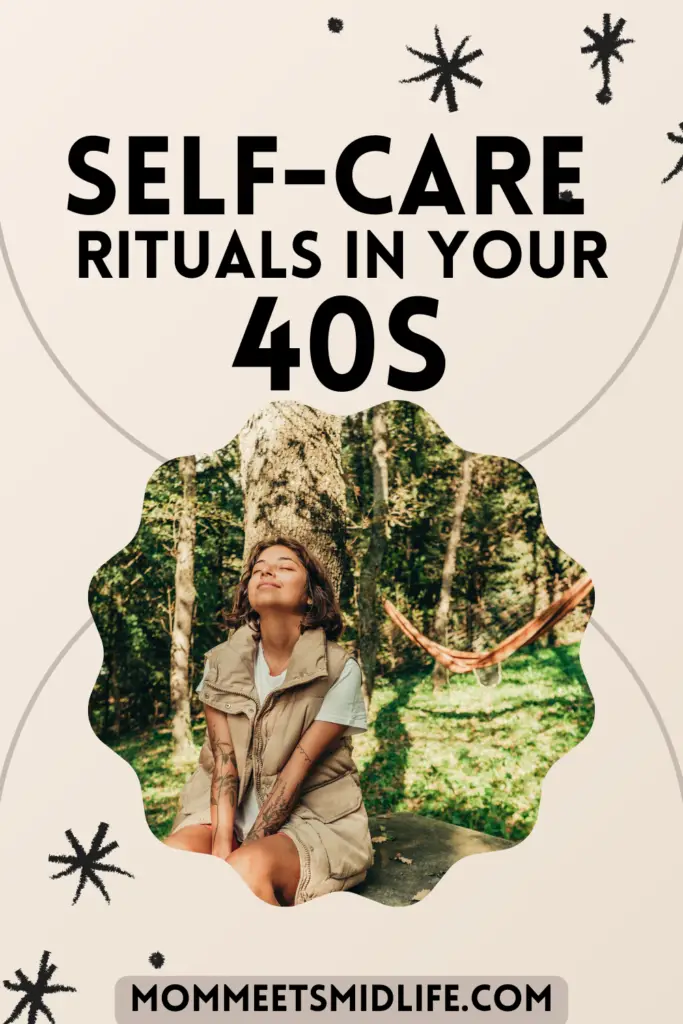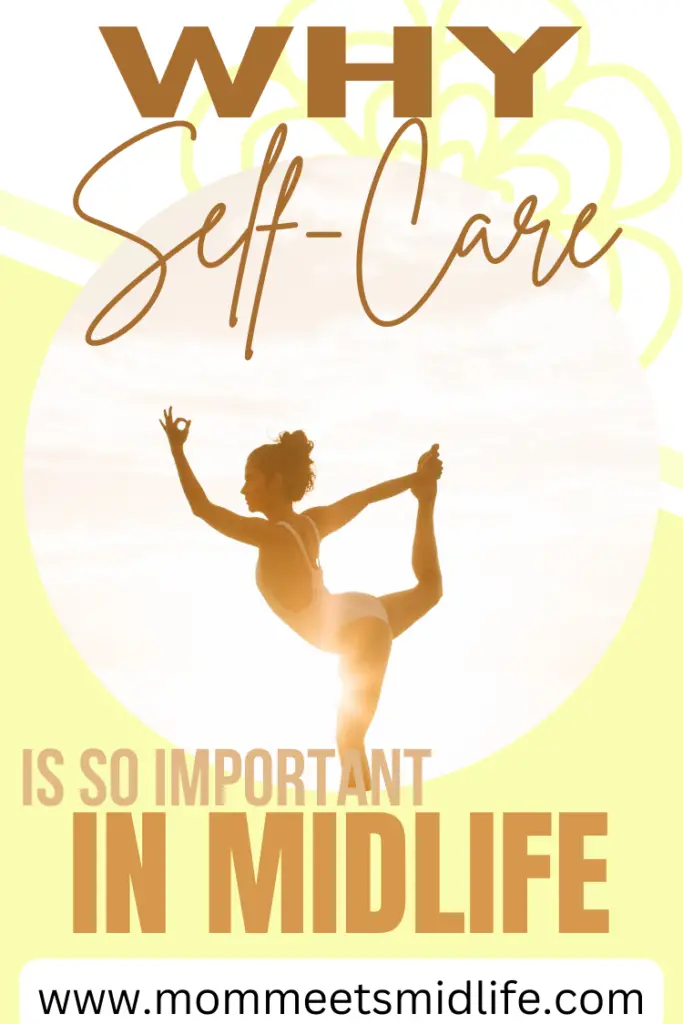Last Updated on October 27, 2024 by Erin
Are you looking for ideas of self-care for midlife women? In this post I will be sharing why self-care is important and provide an extensive list of easy ways to practice self-care.

As we navigate through the challenges of midlife, taking care of ourselves becomes more important than ever. Self-care is the practice of intentionally looking after our physical, emotional, and mental well-being. It is a fundamental aspect of a healthy and fulfilling life, and it is especially crucial during this period of change.
In midlife, we may experience a range of physical and emotional changes, including perimenopause, menopause, career shifts, and changing family dynamics. We may also face an increased risk of developing chronic health conditions such as heart disease, diabetes, and cancer. All of these factors make it essential to prioritize our health and well-being.
**This post contains affiliate links. This means if you click and buy, I may receive a small commission (at zero cost to you). Please see my full disclosure policy for details.**
Reasons why self-care for midlife women is so important:
1. Self-care helps manage stress
Midlife can be a stressful period, and prolonged stress can have significant impacts on our mental and physical health. Practicing self-care activities such as exercise, meditation, or spending time in nature can help manage stress levels and improve overall well-being.
2. Self-care promotes better physical health
Regular exercise, a healthy diet, and getting enough sleep can help prevent chronic health conditions, improve mobility, and promote overall well-being.
3. Self-care supports emotional well-being
Midlife can also be a time of emotional upheaval. Prioritizing self-care activities such as journaling, therapy, or spending time with loved ones can help support emotional well-being and improve the overall quality of life.
4. Self-care can improve relationships
As we take care of ourselves, we can show up as our best selves in our relationships with others. Taking time for self-care activities such as spending time with friends or pursuing hobbies can help strengthen our social connections and improve our relationships.
5. Self-care can help us find purpose
As we navigate the changes of midlife, it can be easy to feel a bit lost. Engaging in self-care activities that bring us joy and fulfillment can help us find meaning and renewed purpose in our lives.
Simple self-care for midlife women:
Take a relaxing bath with Epsom salts and essential oils.
- Lavender essential oil is known for its calming properties, making it an excellent choice for a relaxing bath. It can help reduce stress and promote relaxation, making it a popular choice for bedtime baths.
- Eucalyptus essential oil is a great choice if you are feeling congested or have a cold. It can help open up your sinuses and promote easier breathing. It has a refreshing, invigorating scent.
- Peppermint essential oil is another good choice for congestion and colds, as it can help clear your sinuses and relieve headaches. It also has a cooling effect on the skin.
- Frankincense essential oil has a warm, comforting scent that can help reduce stress and anxiety.
- Rose essential oil has a beautiful, floral scent that can promote relaxation and reduce stress. It also has skin-softening properties.
- Lemon essential oil has a refreshing, uplifting scent that can help improve your mood and boost your energy.
- Chamomile essential oil is known for its calming properties and can help promote relaxation and improve sleep. It is also said to have anti-inflammatory properties and can be soothing for the skin.
If you aren’t comfortable putting essential oils into the bath, you could also run a diffuser in the bathroom. I personally like diffusers that come with soft lighting for ambience. Make sure you are choosing essential oils that are organic and therapeutic grade. Never put essential oils directly onto your skin without diluting it first.
Try a new hobby
Depending on your particular preferences and interests, here are a few hobby ideas you might want to try out:
- painting
- knitting
- gardening
- dancing
- photography
- writing (you could even self-publish your books on Amazon!)
- traveling
- volunteering
- blogging
- baking
- hiking
- cross-stitching (this one is my new favorite and it’s incredibly therapeutic for me)
Get a spa treatment or have a spa night at home
Go get that massage or facial you’ve been wanting!
OR create a relaxing spa environment at home. Light some candles and put on some soothing music to create a calming and peaceful atmosphere.
Give yourself a facial by applying a face mask, either store-bought or homemade, and relax for 10-15 minutes while it does its work. Afterward, rinse it off and apply a moisturizer to leave your skin feeling refreshed and glowing.
Fill a basin with warm water and add some Epsom salts, essential oils, or dried flowers. Soak your feet for 10-15 minutes, then use a pumice stone to gently exfoliate any rough patches. Afterward, apply a foot cream to leave your feet feeling soft and smooth.
Use a natural bristle brush to gently exfoliate your skin before showering or bathing. This can help improve circulation and stimulate the lymphatic system.
Choose spa activities that make you feel calm and rejuvenated.
Read a book or listen to an audiobook.
Reading can enhance creativity by exposing you to different ideas, perspectives, and experiences. It can also provide inspiration for your own creative endeavors. It can encourage self-reflection by providing an opportunity for introspection and self-discovery. Books can also help you better understand your own thoughts and feelings.
And my personal favorite reason to read as a form of self-care is because reading can help reduce stress and promote relaxation by providing an escape from the stresses of everyday life. It can allow you to unwind and detach from the demands of work, family, or other obligations.
Sometimes I really just need an escape from reality AND THAT’S OK!
To save money, I invested in an e-reader and I check out e-books for free from the library. If I can’t easily access a book at the library, or if it’s a book I’d like to add to my personal library, I try to find a gently used copy on ThriftBooks. Finding free or extremely cheap books has helped me reach some pretty incredible reading goals each year!
Spend some time in nature.
Being in nature is an easy way to practice self-care in midlife. It helps reduce stress and promote relaxation by providing an escape from the hustle and bustle of daily life. It can also help reduce the stress hormone cortisol and promote feelings of calmness and well-being.
Spending time in nature can also encourage mindfulness, which involves being fully present in the moment and engaging your senses. Mindfulness is a practice of being present and fully engaged in the current moment, without judgment or distraction. It involves paying attention to one’s thoughts, emotions, and sensations, as well as the environment around them, in a non-judgmental and accepting way.
Practice yoga.
Yoga is known to reduce stress by decreasing the levels of the stress hormone cortisol in the body. It also encourages relaxation and can help to calm the mind and body. Practicing yoga regularly can help to improve flexibility and strength, which can help to prevent injuries and improve posture.
Yoga has also been shown to increase the production of feel-good hormones like serotonin and dopamine, which can improve mood and reduce symptoms of depression.

Attend a workout class.
Find a local workout class geared specifically towards women. My MIL and SIL are both members of a boot camp for women and they attend religiously. If this is something you can accommodate in your budget, go for it! I think it would also be a great opportunity to make friends and share in the comradery of the boot camp experience.
There are also plenty of free workout classes available online, including:
- Fitness Blender – This website offers a wide variety of free workout videos, including strength training, cardio, yoga, and Pilates. Search for free workouts.
- PopSugar Fitness – PopSugar Fitness offers a wide variety of workout videos that can be accessed for free on its website or YouTube channel. They also offer live workouts on Instagram.
- Yoga with Adriene – Adriene offers a wide range of yoga videos for free on her YouTube channel, including videos for beginners and advanced practitioners.
- Blogilates – Cassey Ho’s Blogilates offers free Pilates and strength training videos on her YouTube channel.
- HASfit – HASfit offers a wide variety of free workout videos, including HIIT, strength training, and yoga.
- Darebee – This website offers a wide variety of free workouts that can be done at home, including bodyweight workouts, yoga, and Pilates.
Journal your thoughts and feelings.
There are many amazing benefits to journaling. Helps manage emotions, encourages self-reflection, improves mood, enhances creativity, provides a record of personal growth, and encourages mindfulness…I could go on and on.
To get you started, here are some journal prompts designed to encourage self-reflection, exploration, and growth:
- What am I grateful for today?
- What did I learn from a recent challenge or setback?
- What are my top priorities for the next week/month/year?
- What is something I’ve been avoiding that I need to address?
- What is a goal that I’m currently working towards and what steps can I take to achieve it?
- What are some habits that I want to develop or change?
- What does self-care mean to me and how can I prioritize it in my daily life?
- What is a recent experience that brought me joy and why?
- What are some limiting beliefs that I hold about myself and how can I challenge them?
- What are some ways I can give back to my community or others in need?
You could also create a vision board as a reminder of the things you want and are working towards. Or try a 30-day gratitude challenge!
Get a good night’s sleep.
The amount of sleep that an adult needs can vary from person to person. However, according to the National Sleep Foundation, adults generally need 7-9 hours of sleep per night to function at their best.
Consistently getting less than the recommended amount of sleep can have negative effects on physical and mental health. Chronic sleep deprivation has been linked to a range of health problems, including an increased risk of obesity, heart disease, diabetes, and stroke. It can also lead to cognitive impairment, poor memory and concentration, and an increased risk of accidents and injuries.
So, take care of yourself and make sure you get plenty of shut-eye!
A bubble bath + melatonin + white noise = best friends forever.
Listen to calming music or a guided meditation.
Search for ambient music on YouTube or download the Headspace app.
Headspace is a meditation and mindfulness app that provides guided meditations and other resources to help users manage stress, anxiety, and other mental health issues. The app was created by Andy Puddicombe, a former Buddhist monk who aims to make meditation accessible and easy to practice for people from all walks of life. Headspace offers both a free and a paid subscription option. The free version includes a limited selection of guided meditations and mindfulness exercises, while the paid subscription offers access to the full library of content.
I have used Headspace for 3 years now and I love it. I personally suffer from PMDD and on my really tough days when I’m on edge and anxious, it is a godsend.
Practice deep breathing exercises.
Here is a form of self-care for midlife women that you can do right now while scrolling on your computer or phone. Deep breathing exercises are a great way to reduce stress and anxiety, increase relaxation, and promote a sense of calm. Here are three examples of deep breathing exercises that you can try:
- Abdominal breathing: This exercise involves taking deep, slow breaths from the diaphragm, which can help to promote relaxation and reduce stress. To do this exercise, sit or lie down in a comfortable position and place one hand on your chest and the other on your stomach. Inhale deeply through your nose, feeling your stomach rise as you fill your lungs with air. Exhale slowly through your mouth, feeling your stomach fall as you release your breath.
- 4-7-8 breathing: This exercise involves inhaling for four counts, holding your breath for seven counts, and exhaling for eight counts. This exercise can help to slow down your heart rate and calm your mind. To do this exercise, sit or lie down in a comfortable position and inhale deeply through your nose for four counts. Hold your breath for seven counts, and then exhale slowly through your mouth for eight counts.
- Alternate nostril breathing: This exercise involves alternating between breathing through your left and right nostrils, which can help to promote relaxation and balance in the body. To do this exercise, sit in a comfortable position and place your left hand on your left knee with your palm facing up. Use your right hand to bring your index and middle fingers to your forehead, and then use your thumb to close your right nostril. Inhale deeply through your left nostril, and then close it with your ring finger. Release your thumb and exhale through your right nostril. Inhale through your right nostril, close it with your thumb and exhale through your left nostril. Repeat for several cycles.
Go for a bike ride or hike.
Both of these activities are great for cardiovascular health and are much easier on joints compared to running. These would also be great social activities to do with friends and family to help keep you connected.
And, as mentioned before, you get the benefits of spending time outside and in nature.
Treat yourself to a favorite food or dessert.
Eating food and dessert that we enjoy can bring a sense of pleasure and satisfaction, which can be an important part of self-care. Indulging in a favorite dessert or treating ourselves to a special meal can be a way to show ourselves love.
Give mindful eating a try. Being mindful and present while eating can help us to tune into our hunger and fullness cues and enjoy our food more fully. Here are some steps you can take to practice mindful eating:
- Eliminate distractions: Turn off the TV, put away your phone, and eliminate other distractions while you eat. This will allow you to focus fully on the food and the experience of eating.
- Engage your senses: Take a moment to appreciate the colors, textures, and aromas of the food. Smell it, touch it, and really savor the experience of eating.
- Take small bites: Rather than rushing through your meal, take small bites and chew slowly. This will help you to fully taste and appreciate the flavors of the food.
- Pay attention to your body: Tune into your body’s hunger and fullness cues. Eat until you are satisfied, but not overly full.
- Practice gratitude: Take a moment to express gratitude for the food you are eating, and the nourishment it provides for your body.
Take a technology break and disconnect from social media and screens.
We all know that social media can be a total time suck and can be highly addictive. It’s also really easy to get into a comparison trap while looking at highly curated views of people’s lives. Taking a break can be incredibly helpful and a huge act of self-care.
Decide on a specific time or period during the day when you will disconnect from technology. This could be a few hours in the evening, or a whole day on the weekend. Plan ahead for how you will spend your time during your technology break.
If you are used to spending a lot of time on technology, it can be challenging to suddenly disconnect completely. Start by setting small goals, such as taking a technology break for an hour each day, and gradually work your way up to longer periods of time.
By taking regular technology breaks, you can improve your overall well-being, reduce stress, and promote a greater sense of balance in your life.
Schedule a therapy or counseling appointment.
Therapy gives you a supportive environment to discuss your concerns and feelings. Therapists can also teach you valuable coping strategies for managing stress and anxiety. It can also be a form of preventative care to address mental health concerns before they become more serious.
Finding a good therapist can take time and effort, but it is an important step in prioritizing your mental health and well-being. Here are some tips to help you find a therapist that is a good fit for you:
- Ask for recommendations: Consider asking friends, family members, or your primary care physician for recommendations. You can also check with your insurance provider or use online directories to find therapists in your area.
- Research potential therapists: Once you have a list of potential therapists, take some time to research their credentials, specialties, and approaches to therapy. Many therapists have websites that provide this information, or you can use online directories to find reviews and ratings.
- Consider your needs and preferences: Think about what you are looking for in a therapist. Are you looking for someone who specializes in a particular type of therapy, such as cognitive-behavioral therapy or psychodynamic therapy? Do you prefer a therapist who is warm and empathetic or someone who is more direct and goal-oriented?
- Schedule a consultation: Many therapists offer a free or low-cost consultation, which can be a good opportunity to get a sense of their approach and whether you feel comfortable working with them.
- Trust your instincts: Ultimately, the most important factor in finding a good therapist is whether you feel comfortable and connected with them. Trust your instincts and be willing to try out different therapists until you find the right fit for you.
Call or spend time with a supportive friend or family member.
Spending time with loved ones can be an important form of self-care because it can help to nurture our relationships and provide us with a sense of social support and belonging. It also gives us moments of joy and laughter. Is there anything better than a good belly laugh?
Loved ones can offer emotional support and validation, which can be particularly helpful when we are struggling with challenging emotions or experiences. Many times, we just need a listening ear and someone to tell us our feelings are valid.
Spend time in a quiet and calming space, such as a park or garden.
Spending time in nature, even for a short period of time, can help to reduce stress levels and promote relaxation. Being surrounded by greenery and fresh air can have a calming effect on our bodies and minds.
Get a manicure or pedicure OR give yourself one at home.
If you’re going to give yourself a mani/pedi at home, try using a homemade scrub. Here is a simple recipe for a homemade hand scrub:
Ingredients:
- 1/4 cup granulated sugar
- 1 tablespoon coconut oil
- 1 tablespoon honey
- Optional: a few drops of essential oil for fragrance (such as lavender or peppermint)
Instructions:
- In a small bowl, mix together the sugar, coconut oil, and honey until well combined.
- If desired, add a few drops of essential oil and mix again.
- Rub the scrub all over your hands, focusing on any rough or dry areas.
- Rinse your hands with warm water and pat dry with a towel.
- Follow up with your favorite hand cream for extra moisture.
This hand scrub is a great way to exfoliate and soften your hands, especially during the colder months when dry skin can be more of a problem. The sugar helps to scrub away dead skin cells, while the coconut oil and honey provide moisture and nourishment.
Treat yourself to a favorite movie or TV show.
I have certain “comfort” movies I like to watch. (I’m looking at you, Sorcerer’s Stone). People often have certain comfort movies and shows because they provide a sense of familiarity, nostalgia, and emotional connection. Additionally, comfort movies can provide a sense of escapism and a temporary distraction from stress or anxiety.
Grab that warm fuzzy blanket, pop up some popcorn, and practice some self-care!
Engage in creative expressions, such as drawing or writing.
You don’t have to be a professional artist to express yourself through drawing or doodling. Grab a sketchbook or some paper and let your creativity flow. Draw whatever comes to mind or create patterns and designs that are pleasing to you.
You could also start a blog! Document your journey and help others along the way.
Make Self-Care a Priority
Remember, self-care for midlife women is about prioritizing well-being and taking time for activities that bring joy and relaxation. Choose the activities that work best for you and make them a regular part of your routine.
Self-care is essential in midlife to maintain physical, emotional, and mental well-being. Prioritizing self-care activities can help manage stress, promote better physical health, support emotional well-being, improve relationships, and help us find purpose. By taking care of ourselves, we can navigate the challenges of midlife with greater resilience and enjoy a fulfilling life.
Which of these is your favorite way to practice self-care? Anything new you’re going to try? Anything you would add to the list? Let me know!
Sincerely,
Erin



